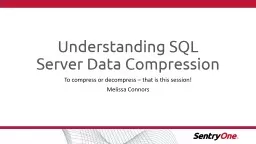PPT-Understanding SQL Server Data Compression
Author : Thunderbolt | Published Date : 2022-07-28
To compress or decompress that is this session Melissa Connors Melissa Connors Senior Technical Writer Special Projects Lead Dog person Befriender of chipmunks
Presentation Embed Code
Download Presentation
Download Presentation The PPT/PDF document "Understanding SQL Server Data Compressio..." is the property of its rightful owner. Permission is granted to download and print the materials on this website for personal, non-commercial use only, and to display it on your personal computer provided you do not modify the materials and that you retain all copyright notices contained in the materials. By downloading content from our website, you accept the terms of this agreement.
Understanding SQL Server Data Compression: Transcript
Download Rules Of Document
"Understanding SQL Server Data Compression"The content belongs to its owner. You may download and print it for personal use, without modification, and keep all copyright notices. By downloading, you agree to these terms.
Related Documents














